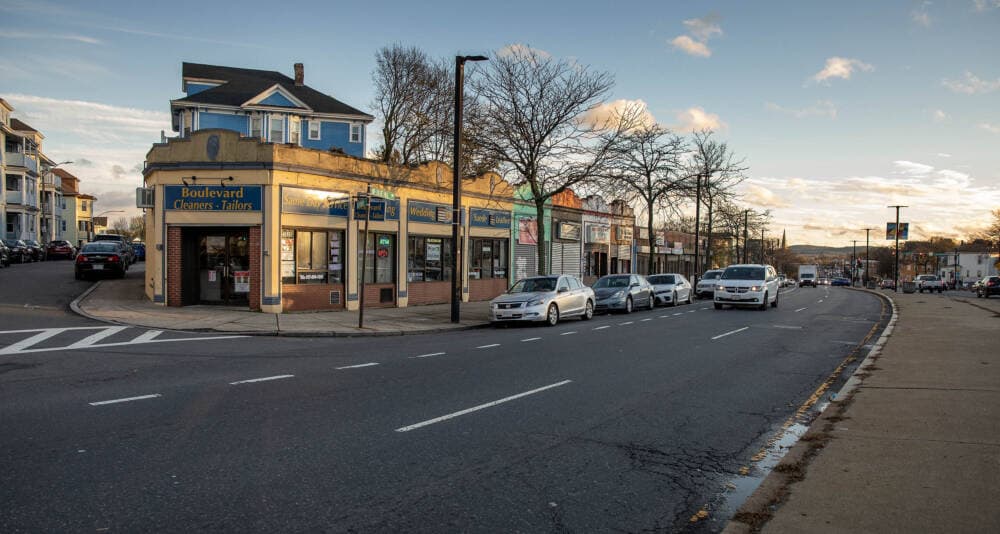Advertisement
Efforts to allow backyard units in Mattapan go before planning board this week

“PLAN: Mattapan,” an effort to remake the neighborhood by allowing backyard residential units and strengthening Mattapan Square as one of the city’s economic hubs, is set to be placed before the Boston Planning and Development Agency’s board later this month.
BPDA officials laid out the final version of the plan, the result of five years of community engagement that builds on previous planning efforts for Mattapan, in an online meeting April 26. If approved, the plan will function as a guide for developers and residents in the years ahead.
A key part of the visioning seeks to make it easier for homeowners to add accessory dwelling units (ADUs) to their property, be they small backyard houses or units added to an existing home that can provide extra income or allow for senior housing as part of an intergenerational household.
“Mattapan is a place that is uniquely positioned to be host to a kind of growth, a kind of gentle density that has a possibility of not only unlocking more opportunities for intergenerational living in the neighborhood, but also, through the addition of ADUs, increase the value of Mattapan homeowners’ homes,” said Arthur Jemison, Mayor Wu’s chief of planning and the head of BPDA.
Sixty-eight percent of Mattapan residents are Black or African American, and 34% of the neighborhood is foreign-born, or not U.S. citizens. Some 43% of homes in Mattapan are valued at less than $400,000, compared to 23% in Boston overall.
The neighborhood also has a higher owner-occupancy rate, 38%, than the citywide average of 35%. And Black homeowners make up 36% of the neighborhood’s owner-occupants, higher than the citywide average of 28%.
The plan recommends a zoning feasibility study aimed at learning how to responsibly implement ADUs. Adriana Lasso-Harrier, a planner with the BPDA, sought to underscore that backyard ADUs will not be implemented “from the get-go.” The study will look at how they fit into Mattapan backyards, she said at the online meeting.
BPDA officials also will work with counterparts in Mayor Wu’s office of housing to develop financial assistance programs for homeowners interested in building an ADU.
PLAN: Mattapan also calls for new crosswalks within the neighborhood to bolster pedestrian safety, and it envisions a “10-minute neighborhood,” meaning more businesses and services throughout the area, closer to where people live.
Advertisement
First released last October, the plan recommends more green space and more tree canopy along corridors such as Blue Hill Avenue, and zoning changes that would allow for increased density and mixed-use development in Mattapan Square. During community meetings, residents also called for more frequent removal of trash and snow, and better maintenance of storefronts.
The BPDA board meeting, set to take place online, is currently scheduled for May 11. If the plan is approved, BPDA officials can implement the recommendations while working with city agencies, as well as outside agencies like the MBTA, to bring the plan to fruition.
Noting that four out of every five Mattapan transit riders use an MBTA bus, PLAN: Mattapan calls for more reliable service, with dedicated bus lanes introduced to Blue Hill Avenue, Warren Street, Malcolm X. Boulevard, and Columbus Avenue, which serve routes 28, 29, 31, and routes 30 and 31 upgraded to “high-frequency” service. Additionally, one bus route to run directly between Mattapan Square and the Longwood Medical Area (LMA).
Since Mattapan sometimes serves as a cut-through for commuter traffic, the plan recommends express bus service between cities and towns south of Boston and the LMA, and an expansion of service between the medical area and JFK/UMass MBTA Station.
“Over 20 percent of vehicles passing through Mattapan Square on weekday mornings are destined for LMA, Jamaica Plain, and Roxbury, areas with job opportunities but limited highway access and poor cross-town bus connectivity,” the plan notes.
As for rapid transit, the plan takes a look at the Fairmount Line, a commuter rail track that runs from South Station through Dorchester and Mattapan to Hyde Park. It sees the line as electrified so that it can run trains every 10 to 15 minutes, with stations added at River Street and Columbia Road. A south entrance would also be added to the existing Morton Street Station, along with a new pedestrian bridge.
As for the Mattapan trolley line, which is due for an overhaul of its stations and a shift away from its historic cars to the light rail vehicles now in use on the Green Line, the plan recommends that the MBTA consider extending the Mattapan Line to Readville and perhaps beyond.
All this is coming into play as several concurrent and related efforts are underway:
- The city’s transportation department is undertaking its own “action plan” for the Blue Hill Avenue corridor, which stretches three miles from Mattapan Square to Grove Hall. Design work is planned throughout 2023, with construction set to start in late 2024.
- Cummins Highway, a top location for crashes in the city, is also seeing reconstruction through the addition of shade trees, better street lighting, bike lanes, and sidewalks.
- The Public Works Department is reconstructing River Street’s sidewalk, and the Transportation Department has downsized the intersection of Babson Street and Mildred Avenue, close to the K-8 school and the community center, in order to slow down speeding cars and heighten drivers’ visibility of pedestrians.
WBUR and the Dorchester Reporter have a partnership in which the news organizations share resources to collaborate on stories. This story was originally published by the Dorchester Reporter.